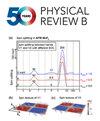液态氦到室温下4h -SiC中空位的光学探测磁共振谱演变
IF 3.7
2区 物理与天体物理
Q1 Physics and Astronomy
引用次数: 0
摘要
由于其自旋和光致发光(PL)特性以及接近电信PL发射,4H-SiC中的空缺引起了人们的极大关注。然而,它们的光学探测磁共振(ODMR)光谱的解释存在一些含糊之处,特别是在高温下。在这项研究中,我们使用PL和ODMR研究了PL1-PL7的距离配置。我们记录了用两种不同的激光能量和不同的激光偏振获得的液氦温度(3.8 K)和室温(295 K)之间的完全温度依赖关系。我们还提供了与ODMR同时记录的PL数据。我们的研究使我们能够持续跟踪ODMR中所有距离构型随温度的演变,即使它们的特征在高温下在PL中无法区分。我们确定了室温ODMR光谱中的所有线,并表明在早期工作中假设的源于另一种距离配置的假设缺陷PL7不存在,其室温下的ODMR信号可以用PL4完全解释。我们还提供了关于PL5、PL6和一个新的PL3a缺陷的空间分布的直接PL证据,表明它们仅在样品表面附近存在,从而证实了它们与堆积缺陷附近的空缺的关联。我们还讨论了在较高温度下观察到的ODMR光谱中光致发光上转换的作用。2025年由美国物理学会出版本文章由计算机程序翻译,如有差异,请以英文原文为准。
Evolution of the optically detected magnetic resonance spectra of divacancies in 4 H -SiC from liquid-helium to room temperature
The divacancies in 4H-SiC attract significant attention for use as qubits owing to their spin and photoluminescence (PL) properties and near telecom PL emission. Nevertheless, there exist some ambiguities in the interpretation of their optically detected magnetic resonance (ODMR) spectra, especially at elevated temperatures. In this study, we investigate the divacancy configurations PL1–PL7 using PL and ODMR. We record the full temperature dependence between liquid-helium temperature (3.8 K) and room temperature (295 K), obtained with two different laser energies and different laser polarizations. We also present PL data recorded simultaneously with the ODMR. Our study allows us to continuously follow the evolution of all divacancy configurations in ODMR with temperature, even though their signature is not distinguishable in PL at elevated temperatures. We identify all lines in the room-temperature ODMR spectrum and show that a hypothetical defect PL7, assumed in earlier work to stem from another divacancy configuration, does not exist and its ODMR signal at room temperature is fully explained with PL4. We also provide direct PL evidence on the spatial distribution of PL5, PL6, and a new PL3a defect, showing their presence only close to the surface of the sample, thus corroborating their association with divacancies near stacking faults. We address also the role of the upconversion of the photoluminescence in the ODMR spectra observed at higher temperatures. Published by the American Physical Society 2025
求助全文
通过发布文献求助,成功后即可免费获取论文全文。
去求助
来源期刊

Physical Review B
物理-物理:凝聚态物理
CiteScore
6.70
自引率
32.40%
发文量
0
审稿时长
3.0 months
期刊介绍:
Physical Review B (PRB) is the world’s largest dedicated physics journal, publishing approximately 100 new, high-quality papers each week. The most highly cited journal in condensed matter physics, PRB provides outstanding depth and breadth of coverage, combined with unrivaled context and background for ongoing research by scientists worldwide.
PRB covers the full range of condensed matter, materials physics, and related subfields, including:
-Structure and phase transitions
-Ferroelectrics and multiferroics
-Disordered systems and alloys
-Magnetism
-Superconductivity
-Electronic structure, photonics, and metamaterials
-Semiconductors and mesoscopic systems
-Surfaces, nanoscience, and two-dimensional materials
-Topological states of matter
 求助内容:
求助内容: 应助结果提醒方式:
应助结果提醒方式:


